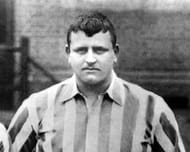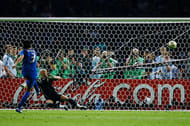If you are a fan of the England national team, you would know what a penalty kick is. You may not know how it is taken appropriately, but you will definitely know what it is.
The point is that, everyone who follows football knows what a penalty is because it has been a part of the game since the time we have started watching it, and many, many years before that as well.
But no matter how workaday the humble penalty may appear to us today, it wasn’t always the case. Like many rules and regulations of the sport, the penalty too was ‘added on’ and not a part of the sport from the very beginning.
Why was the rule enforced?
The penalty kick was invented in the year, 1890 by an Irish footballer by the name of William McGann. McGann was a goalkeeper himself, who played for Milford FC in the very first season of the Irish league.
However, it was a member of the Irish Football Association who was pivotal in making the idea of a penalty kick one of the laws of the game. Defenders were finding it easy to stop oncoming attackers from scoring a goal by fouling them close to the goal – the 12-yard area which we now know as the penalty box. The proposition to make the penalty kick a law was to prevent this very dirty trick used by defenders. The proposition was accepted, and it became a part of the rules as Rule number 13. in 1891. The law read:
“If any player shall intentionally trip or hold an opposing player, or deliberately handle the ball within twelve yards from his own goal line, the referee shall, on appeal, award the opposing side a penalty kick, to be taken from any point 12 yards from the goal line, under the following conditions: All players, with the exception of the player taking the penalty kick and the goalkeeper, shall stand behind the ball and at least six yards from it; the ball shall be in play when the kick is taken. A goal may be scored from a penalty kick.”
How the rule has evolved over the years
When the penalty rule was just introduced, the kick could be taken from anywhere along a line, parallel to the goal and 12 yards away from it. It was only in 1902 when the penalty spot was introduced and it is still used today. In 1937, the D-line was introduced which forced the players other than the spot kick taker to stand behind the D. Up until then, players could stand anywhere they liked on the penalty line which often made it confusing and harder for the goalkeeper to concentrate.
Another important altercation which was made to the rule was that of the goalkeeper not allowing moving off his line. This was not always the case, and was changed thanks to a certain Willie Foulkes.
Foulkes used to play for Sheffield United before his transfer to Chelsea in 1905. He had already won a reputation as a brilliant shot stopper when it came to the spot kick. But what was interesting was the way he used to save penalties.
Foulkes was an imposing figure at 6 feet 3 inches, and weighing around 330 pounds. He absolutely hated it when a penalty was rewarded against his team. To stop the kick taker from scoring, he would often charge down his line to intimidate him. Apparently, this ploy of his was mightily successful which is why the authorities introduced the rule for goalies wherein it was mandatory for them to remain on their line.
Foulkes was also responsible for the development of a widely used footballing jargon. After Chelsea, Foulkes moved on to Bradford City. While playing Accrington Stanley, Foulkes damaged his jersey and could not find a suitable sized replacement. A sheet was obtained from a nearby house which he wrapped around himself. Foulkes then went on for the whole match without diving and still winning the match 1-0, and hence the phrase, “to keep a clean sheet” was born.
Origin of penalty shoot-outs
Whenever we see a tied game in football these days in a match which needs a definite winner, we see the match advance to extra time. However, we hope to see it advance all the way to a penalty shoot-out (unless the team you support is terrible at it) because it is so thrilling to witness.
In the past, tied games used to be decided by either a coin toss or a replay. But coin tosses are unfair as it is attributed solely to luck, and replays take more time, are physically more taxing on players and also costs more to the organizers. A penalty shoot-out therefore is a great way to combat these difficulties while obtaining a fair result too.
The idea of the modern day shootout is credited to Israeli, Yosef Dagan who gave the proposition after seeing his national team crash out of the 1968 Olympic quarter finals due to drawing of lots. The Israeli FA, with backing by the Malaysian FA’s referee committee led the move for its adoption by FIFA. After some discussions, the International Football Association Board (IFAB) although “not entirely satisfied”, adopted the proposal on 27 June, 1970.
Development of penalty shootouts
In England the first ever penalty shoot-out was won by who other but Manchester United? It was against Hull City during the semi-final clash of the Watney Cup in 1970. The first player to take a kick was George Best, and the first to miss was Denis Law. Ian McKechnie, who saved Law's kick, was also the first goalkeeper to take a spot kick.
The first ever European Cup shoot-out was between Everton F.C. and Borussia Monchengladbach, with Everton winning 4–3.
As for major international tournaments, the first shoot-out was in the 1976 European Championship final between West German and Czechoslovakia. UEFA had made the provision of a replay two days later, but both the teams decided to opt for a shoot-out instead, which resulted in a 5-3 win for Czechoslovakia.
The first penalty shoot-out in the World Cup was on 9 January 1977, in the first round of African qualifying, when Tunisia beat Morocco. The first shoot-out in the finals tournament was in 1982, when West Germany beat France in the semi-final. If the 1982 final had been drawn, penalties would not have applied unless the replay was also drawn; from 1986, penalties were scheduled after the final as for the earlier knockout rounds.
Do penalty-shootouts favour the attacker?
The purists of the game however, were not happy with the introduction of this revolutionizing idea of a shoot-out. Football according to them was a free flowing game which is quickly resumed if there is a foul or the ball goes out of play. A penalty easily takes a minute or so out of the game on an average – something the purists could not tolerate.
As for shoot-outs, surely there should be a better way to decide games? By 1994, the shoot-out decided the World Cup finals itself, and by 1998, 3 more teams were knocked out courtesy this new rule. But if there has ever been an alternative to it, FIFA has been unable to find it, and we still carry on with the shoot-outs.
Penalties are also looked upon as largely favouring the player attempting to score rather than the goalie. A scorer is likely to score 76% of the times on an average. Even ice hockey which has the most similar penalty taking style as football has an average scoring chance of a meagre 40%. That’s why it’s more than fair to say that this rule has skewed the game slightly in favour of the attacker. The changing definitions of what is a foul and what is not makes life even harder for defenders. While a double studded challenge was regulation a few decades ago, the same results in an immediate red card more often than not in today’s times.
Having said all this though, the penalty has still been a welcome addition to the sport and has taken many malpractices on the field out of the picture. There are criticisms and controversies, but then that is the case with almost every rule in every sport.
Penalties and penalty shoot-outs have become such an integral part of the game these days that it is close to impossible to imagine it without them. It brings more balance and fairness to the game by eliminating certain ambiguities that were prevalent in the past. Not to mention the drama and the adrenaline rush it adds too.
Imagine how different the Italy vs. France 2006 World Cup finals would have been if not for the penalty shoot-outs. Or the Manchester United vs. Chelsea thriller in the European Cup finals of 2008 which is still talked about so much(Video below). Or even the iconic Ivory Coast vs. Ghana (probably also because of Gervinho’s expressions or lack thereof) penalty shoot-out in the AFCON this year which went down to the very end.
Think of the thousands of penalty decisions during the 90 minutes of a game too. So many matches and tournaments could have had different results had this rule not been in place. The game is much richer thanks to this rule, and let’s not forget the chance it gives us to scream in anticipation or revolt when a player goes down in the box.


